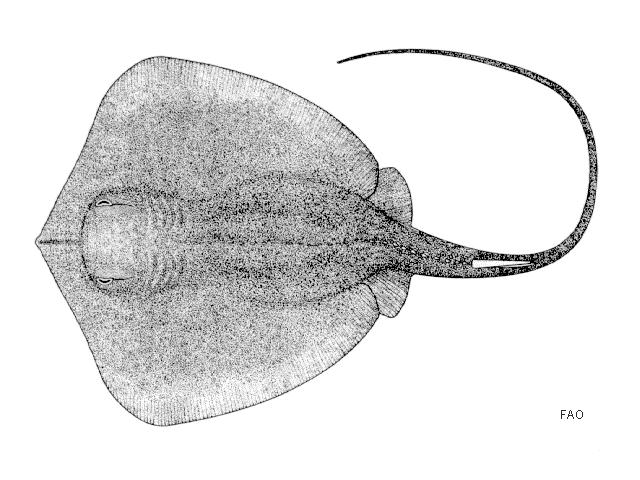Hemitrygon akajei
(Müller & Henle, 1841)
Red stingray
Classification: Elasmobranchii Myliobatiformes Dasyatidae
Reference of the original description
Systematische Beschreibung der Plagiostomen. Berlin, Veit, pp. 1–200
Systematische Beschreibung der Plagiostomen. Berlin, Veit, pp. 1–200
Image of the original description
.jpg)
Hemitrygon akajei (Müller & Henle, 1841)
.jpg)
Hemitrygon akajei (Müller & Henle, 1841)
Synonyms / new combinations and misspellings
Dasyatis akajei, Dasyatis akajel, Dasyatis cf. akajei, Dasybatus akajei, Trygon akajei, Trygon (Trygon) akajei
Dasyatis akajei, Dasyatis akajel, Dasyatis cf. akajei, Dasybatus akajei, Trygon akajei, Trygon (Trygon) akajei
Types
Hemitrygon akajei
Dasyatis akajei
Lectotype: RMNH: 4255a Paralectotype: RMNH: D2456 RMNH: D2451 RMNH: D2452 RMNH: D2449 RMNH: 4255b RMNH: D2450
Hemitrygon akajei
Dasyatis akajei
Lectotype: RMNH: 4255a Paralectotype: RMNH: D2456 RMNH: D2451 RMNH: D2452 RMNH: D2449 RMNH: 4255b RMNH: D2450
Description :
Citation: Hemitrygon akajei (Müller & Henle, 1841): In: Database of modern sharks, rays and chimaeras, www.shark-references.com, World Wide Web electronic publication, Version 11/2024
Please send your images of "Hemitrygon akajei" to info@shark-references.com

Hemitrygon akajei (Müller & Henle, 1841), © FAO, www.fish-base.org

Hemitrygon akajei (Müller & Henle, 1841), © FAO, www.fish-base.org
Common names
 Peitschenrochen,
Peitschenrochen,  Stechrochen,
Stechrochen,  Pastinaca,
Pastinaca,  Raya látigo del Pacífico,
Raya látigo del Pacífico,  Pastenague du Pacifique,
Pastenague du Pacifique,  Brown stingray,
Brown stingray,  Estuary stingaree,
Estuary stingaree,  Japanese red stingray,
Japanese red stingray,  Japanese stingray,
Japanese stingray,  Red skate,
Red skate,  Red stingray,
Red stingray,  Whip ray,
Whip ray,  Whip stingray,
Whip stingray,  Whipray,
Whipray,  Yellow stingray,
Yellow stingray,  Pastinaca,
Pastinaca,  Trigono,
Trigono,  Uge do Pacífico
Uge do Pacífico
 Peitschenrochen,
Peitschenrochen,  Stechrochen,
Stechrochen,  Pastinaca,
Pastinaca,  Raya látigo del Pacífico,
Raya látigo del Pacífico,  Pastenague du Pacifique,
Pastenague du Pacifique,  Brown stingray,
Brown stingray,  Estuary stingaree,
Estuary stingaree,  Japanese red stingray,
Japanese red stingray,  Japanese stingray,
Japanese stingray,  Red skate,
Red skate,  Red stingray,
Red stingray,  Whip ray,
Whip ray,  Whip stingray,
Whip stingray,  Whipray,
Whipray,  Yellow stingray,
Yellow stingray,  Pastinaca,
Pastinaca,  Trigono,
Trigono,  Uge do Pacífico
Uge do Pacífico
Short Description
Disc rhomboid, anterior margin straight, posterior margin convex. Snout triangular and slightly produced. dorsal keel present on tail. Adults with small spines on disc and posterior part of tail. Brown dorsally and some with orangish pectoral fin margins, in front of eyes, behind spiracles, on the sides of the tail just anterior to the sting. Ventrum orangish red.
Disc rhomboid, anterior margin straight, posterior margin convex. Snout triangular and slightly produced. dorsal keel present on tail. Adults with small spines on disc and posterior part of tail. Brown dorsally and some with orangish pectoral fin margins, in front of eyes, behind spiracles, on the sides of the tail just anterior to the sting. Ventrum orangish red.
Distribution
Western Pacific: southern Japan to Thailand. Also known from Fiji and Tuvalu [20066]. Source: www.gbif.org
Western Pacific: southern Japan to Thailand. Also known from Fiji and Tuvalu [20066]. Source: www.gbif.org
Human uses
fisheries: commercial; aquarium: commercial
fisheries: commercial; aquarium: commercial
Biology
Exhibit ovoviparity (aplacental viviparity), with embryos feeding initially on yolk, then receiving additional nourishment from the mother by indirect absorption of uterine fluid enriched with mucus, fat or protein through specialised structures [733]. Distinct pairing with embrace [17086]. Inhabits sandy areas in coastal waters [17641]; also coral reefs (Ref. 58534).
Exhibit ovoviparity (aplacental viviparity), with embryos feeding initially on yolk, then receiving additional nourishment from the mother by indirect absorption of uterine fluid enriched with mucus, fat or protein through specialised structures [733]. Distinct pairing with embrace [17086]. Inhabits sandy areas in coastal waters [17641]; also coral reefs (Ref. 58534).
Size / Weight / Age
200 cm TL (male/unsexed; (Ref. 637)); max. published weight: 10.7 kg (Ref. 40637)
200 cm TL (male/unsexed; (Ref. 637)); max. published weight: 10.7 kg (Ref. 40637)
Remarks
shark-references Species-ID=14615;
shark-references Species-ID=14615;
Parasites (arranged by Jürgen Pollerspöck)
Monogenea
Cestoda
Nematoda
Copepoda
Isopoda
Hirudinea
Monogenea
- Dendromonocotyle akajeii Ho & Perkins, 1980 [17437] [9445] [27164]
- Heterocotyle chinensis Timofeeva, 1983 [9644] [22929]
Cestoda
- Acanthobothrium coronatum (Rudolphi, 1819) Van Beneden, 1850 [16448] [28741]
- Acanthobothrium dasybati Yamaguti, 1934 [16458] [16175] [16448] [28741]
- Acanthobothrium grandiceps Yamaguti, 1952 [16129] [16448] [28741]
- Acanthobothrium guanghaiense Yang, Sun, Zhi, Iwaki, Reyda & Yang, 2016 [24607] [28741]
- Acanthobothrium ijimai Yoshida, 1917 [16129] [16175] [16448] [28741]
- Acanthobothrium latum Yamaguti, 1952 [16129] [16175] [16448] [28741]
- Acanthobothrium macrocephalum Wang & Yang, 2001 [16437] [24607] [28741]
- Acanthobothrium micracantha Yamaguti, 1952 [16129] [16175] [16448] [28741]
- Acanthobothrium ningdense Yang, Sun, Zhi, Iwaki, Reyda & Yang, 2016 [24607] [28741]
- Acanthobothrium tsingtaoensis Tseng, 1933 [16448]
- Barbeaucestus shipleyi (Southwell, 1912) [16458] [16247]
- Cephalobothrium longisegmentum Wang, 1984 [24952]
- Clistobothrium tumidum (Linton, 1922) [16443]
- Echeneibothrium flexile (Linton, 1890) [16458]
- Lecanicephalum peltatum Linton, 1890 [24952]
- Nybelinia aequidentata (Shipley & Hornell, 1906) [16112]
- Phyllobothrium bifidum Yamaguti, 1952 [16129]
- Phyllobothrium dasybati Yamaguti, 1934 [16458] [16443]
- Pterobothrium lintoni (Maccallum, 1916) Dollfus, 1942 [16458] [16283] [16112]
- Rhinebothrium sp. [16908]
- Rhodobothrium pulvinatum Linton, 1889 [21508]
- Scalithrium sp. [24952]
- Tetragonocephalum akajeinensis Yang, Liu & Lin, 1995 [16464]
Nematoda
- Mawsonascaris laymani (Mozgovoi, 1950) [21225] [17029]
- Terranova amoyensis Fang & Luo, 2006 [7572]
- Terranova sp. [21235]
Copepoda
- Eudactylina dasyati Izawa, 2011 [14349] [17500]
- Eudactylinella alba Wilson, 1932 [14314]
- Trebius akajeii Shiino, 1954 [14624]
Isopoda
- Gnathia capillata Nunomura & Honma, 2004 [21435]
- Gnathia sp. [21440]
- Gnathia trimaculata Coetzee, Smit, Grutter & Davies, 2009 [17188]
Hirudinea















